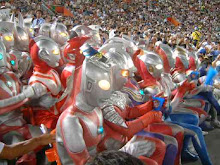I just read 14 pages of THIS.
It's called "2nd Shift" by J. Gray.
I really didn't think that there was anything interesting to write about with this comic, but I'm too tired to go back and start searching again. I chose this one because I thought it was going to be about some kind of aliens working at a copy shop. That sounded great to me. No aliens as of yet.
Luckily for me, I reached page 14. This page was the first one which interested me to any great degree. Oddly enough, it was the first page to encorporate a whole slew of neat comic writing techniques.
First off, we have narration on this page, not simply traditional dialogue. Most panels on this page have both dialogue and narration running simltaneously. McCloud talks about the "desperate device-ness" of the dialogue bubble (word balloon) and references some attempts to subvert it on page 134 of his Understanding Comics guide, and this comic uses an excellent creative solution here. In addition to the traditional dialogue bubble, the author uses a drawing of a torn-off page from a notebook with hand writing on it, rather than standard comic font text.
This is quite effective in communicating the tone of the words. The character we're watching perfrom the action is almost interpreted as a background to the narrator's notes. While the "handwritten" notes are on the bottom of each panel, they're interpreted as the foreground of the panel.
I also found this to be the most compositionally interesting page of the comic. If we look at the first panel, we see the figure on our left hand side in the foreground, is logically much taller than any of the other figures and her line of sight is fixed towards the bottom right hand side of the panel. since the figure on the right hand side is in the background, he is smaller and less "weighty" composition wise. Intelligently, the author has repeated the figures form in the line of customers to the right. This helps balance the frame.
The second panel is excellently symmetrical. Equally sized figures stand on either side with dialogue on the top center and narration on the bottom center. If feels like a nice, square box. This compositional style follows for the next three frames until the last frame, which mirrors the composition of the first frame where a line of weight implied from top left to bottom right. In the final frame, the artist actually draws a lightning bolt reinforcing the line.
The last frame is also an anomaly so far in the comic in that is isn't a drawing of two people having a conversation. There is a break in the linear narrative which signifies a momentous change on the horizon. We'll see how and if that comes to fruition.
This page also functions most effectively as a self-contained, active narrative.
The characters and background artwork is what McCloud would call, "Cartoony" which leaves more room for the reader to superimpose themselves or their impressions onto the characters, rather than focusing on the beauty of highly-stylized artwork.
Scott McCloud, in his book, Understanding Comics, discusses the different impacts of various drawing styles. He states that the more simplified, iconic and "cartoony" the character is, the better the reader is able to project his own image onto that character, whether that image is the reader themselves, or a person imagined by the reader. If the character is drawn more detailed and realistically, then there is less room for the reader to fill in the gaps with their imagination. Thank you for pointing out that I didn't explain that at all!
Also, here is a screen shot of page fourteen, the page I wrote about, just click on it for a larger view. Enjoy!


Hello. I wanted to thank you for this insightful analysis of that page. I'm the artist/writer. You gave me a lot of food for thought as I read your blog, then reexamined the page itself. Some of what you saw was intentional but not conscious (I didn't think to myself - I want X to be balanced. I just naturally sought balance there. For example) and some of it (such as the monotone customers lined up in front of Az and the use of both narration and dialogue) was intentional and conscious.
ReplyDeleteSo, thank you. This was wonderful to read.
As a side note, the unusual things start happening after this page, with what could be an alien arriving about 6 pages later.
ReplyDeleteI've read this comic, so I managed, but I think reviews like this benefit from including a page of sample art. Otherwise it's a bad seat at the movies.
ReplyDeleteI enjoyed it from p 2. Tastes vary.
I'd be keen to know the original source of McCloud defining "cartoony."
Cool - glad to see a writeup on 2nd Shift! I took a while to get into it, but I'm pretty well hooked now. You gotta keep going past page 14 - but I really enjoyed your analysis of why that page really clicks. *high five*
ReplyDeleteJ. Gray,
ReplyDeleteThank you for reading.
I agree that people (artists included) tend to seek balance compositionally. Usually if it's startlingly offset, it's a deliberately employed device used to create tension. Sometimes, creating balance is extremely difficult to do well. Imagine you're creating a landscape, you may naturally want it to feel balanced, but you probably won't want to paint a barn on the left, a barn on the right, and a pond with a sun setting over it dead center. So, doing something like having one barn on the left, with two smaller structures on the right to balance it is a more pleasing way to dissolve compositional tension.